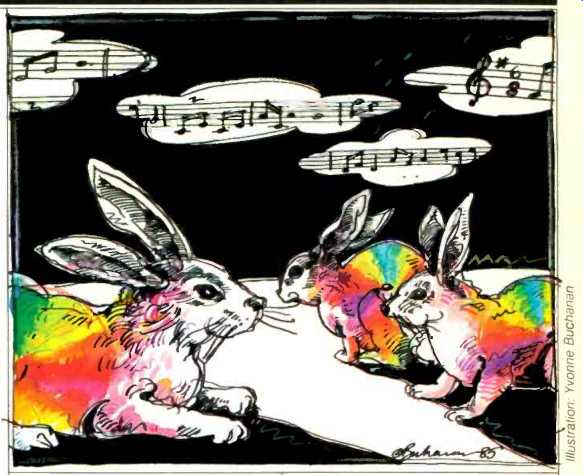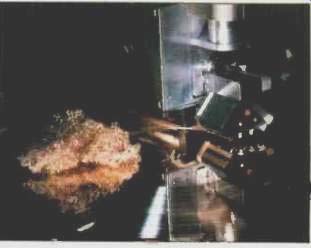NEW REPRODUCTIVE SYSTEMS

The audio world seems to be caught up in the glamour and excitement of digital recording and the digital Compact Disc. After a slow start, CD players and software are proliferating at an incredible rate.
In fact, the CD software situation has gotten rather out of hand. The seven CD pressing plants around the world are working around the clock, trying to keep up with demand. Just recently, the new DADC plant in Terre Haute, Indiana issued a bulletin stating they would no longer accept custom pressing orders, but would restrict themselves to CBS productions. They followed this up by announcing an allocation system for supplying CD retailers in the U.S. (As you may know, DADC is a joint venture of Sony and CBS.) The overtaxed CD production facilities have been a particular hardship for many of the smaller record companies who are trying to jump on the CD bandwagon. Some of the CD plants are now quoting lead times of four to five months. Further, many of the CD pressing plants are giving priority to hot new pop recordings; thus, catalog items suffer, and out-of-print productions are delayed in repressing and restocking.
As you are aware, CD players are now available at an official-low $299 list price, with discounts widely offered. While these certainly are bare bones units, they nonetheless satisfy the requirements of many people.
There are more than 30 models of CD players with more elaborate facilities at higher prices. Even at this early stage of CD development, specialized, audiophile-type CD players are available from Meridian, Mission, and Cambridge Audio; another is coming from McIntosh.
What is happening in record marketing is also interesting. Tom Jung, whose Digital Music Productions issues his superb recordings in just CD and chrome cassette formats, tells me that his sales are 90% CDs to 10% cassettes. Telarc sales are heavily weighted to the CD format, too. Even the major record companies are occasionally issuing recordings only on CD; a case in point is the von Karajan performance of the Mahler Ninth Symphony on Deutsche Grammophon.
Does all this frenetic CD activity signal the imminent demise of the LP vinyl record? Some ultra-enthusiastic CD boosters among the industry pundits are blithely prognosticating that the vinyl LP recording will be in a terminal decline within three to five years! It would be foolish not to recognize the tremendous potential of the CD format (to say nothing of other digital formats that may appear). There is little doubt that CD sales will command a very significant percentage of the overall recorded music market in the next few years (as do prerecorded cassette sales, which in 1984 topped LP sales for the first time!). Having said all this, it must be noted that the vinyl LP is a tough old bird, with a great deal of resilience. It has survived predictions of its demise in the past. For example, it was "doomed" by the arrival of stereo on prerecorded open-reel tape in 1954.
Then came Westrex 45/45 stereo discs in 1958. It was postulated that the vinyl disc couldn't handle quadraphonic sound-tape was the only medium that could. As it turned out, you can say that the whole idea of quadraphonic sound was either ill-conceived or premature, but still, the vinyl LP accommodated itself to this medium too.
But now, in light of all the digital and CD activity, has the old LP reached the end of its technological tether? Back in 1976, I was visiting Decca Records in London. With my dear old friend Arthur Haddy, Decca's director of engineering, showing me around his studio facilities, we went into a room which was dominated by a huge recording lathe of unusual design. In place of the usual lacquer mastering disc on the turntable was a gleaming, bright copper disc. Arthur explained that this was their experimental recording system for videodiscs! When I said it would be a great thing if some of this new technology could be applied to audio discs, Arthur said that, down the line, this was just what they had in mind.
Thus in 1982, Teldec of West Germany, originally a joint venture between Telefunken and Decca Records, introduced the DMM-Direct Metal Mastering-process. Developed by Teldec technical director Dr. Horst Redlich, the DMM process uses a special Neumann VMS 80 recording lathe, with the Neumann SX 80 CM stereo cutter head. A new type of diamond cutting stylus, without the usual burnishing facets, cuts grooves on a layer of copper, electrolytically deposited on a stainless-steel substrate. These copper-plated discs must be used for cutting within two to three days after they are plated, while the copper is still in an amorphous state and relatively easy to cut. In less than a week, the copper plating becomes crystalline in structure and cannot be used for cutting.
During the cutting, the diamond stylus is excited at an ultrasonic frequency (about 80 kHz) whose amplitude increases with increasing groove depth. Because of the mechanical resistance of the copper, the cutting stylus must have a vertical tracking angle of virtually 0°. Thus, a compensating network is used to electronically simulate a normal vertical tracking angle.
No stylus heat is necessary, and since there are no burnishing facets on the stylus, there are no "horns" formed on the groove edge. Because copper is used, there is no elastic deformation or spring-back distortion, as in lacquer cutting, and therefore no pre- or post-groove echo. This makes possible 15% more playing time, without reduction of levels or bass frequencies. The elimination of elastic deformation also results in superior transient response.
The DMM cutting produces a copper mother, and no complex silvering (as with lacquers) is needed, which means greater economy. Since direct stamper production is possible, the pressing of a hot new pop recording can be accomplished within two hours! The DMM cutting produces an extremely smooth groove wall and retains high frequencies, with low distortion, even at inner groove diameters. Signal-to-noise ratios are typically 70 dB or better. As compared to normal lacquer cutting, there is at least a 6-dB improvement in noise at mid- and high frequencies as well as a dramatic reduction of low-frequency noise (rumble, etc.), up to 15 dB. Pressings made on high-quality Teldec vinyl are virtually free of ticks and pops.
In 1982, I had intended to bring you an extended report on DMM but was deterred by a phenomenon that I and some British critics had noticed. The DMM recordings are superior in terms of noise, transient response and frequency response, but when played on really high-quality, wide-range audio systems, there was, back then, an overly bright, "tizzy" top end. This was exacerbated by many moving-coil cartridges that have high resonant peaks around 17 to 20 kHz.
I conferred with Dr. Redlich of Teldec at the 1983 AES Convention in Anaheim. I suggested that since DMM pressings are not subject to the plating and pressing high-frequency losses found with conventional lacquer cutting, the RIAA cutting curve might be rolled off a little to compensate for the overly bright top end. He seemed to agree with me, but I haven't noticed much difference on recent DMM pressings.

above: Neumann system cutting a DMM master.
Thousands of people are enjoying the very considerable benefits of DMM on reasonably good hi-fi systems. For hypercritical listeners with very high quality systems, there may be some relief in sight. Joe Grado has a new tonearm and cartridge of unusual design, said to represent some new ideas and technology in the cartridge/record-groove interface. It is rumored that his combination is very compatible with DMM records (and I plan to audition it in the near future to see if it does indeed improve and enhance the virtues of DMM recordings). Perhaps as the DMM process becomes more widespread, other manufacturers will develop equipment to cope with the high-frequency anomaly of DMM pressings. Of course, ideally, it is to be hoped that Teldec will manage to correct this problem on their DMM pressings, so everyone can enjoy the advantages of this brilliant technology.
As of now, DMM pressings are available from Teldec and from EMI, and I understand Telarc has cut a few. CBS is said to be planning to import the requisite Neumann lathes and cutter heads, and associated DMM equipment, in the near future.
So once again, the venerable vinyl LP has a new lease on life, through the upgrading of DMM technology. Some may regard it simply as a finger in the hole in the dike, which will do little to stem the digital CD tide, but it may be around longer than anticipated.
(adapted from Audio magazine, Bert Whyte)
= = = =